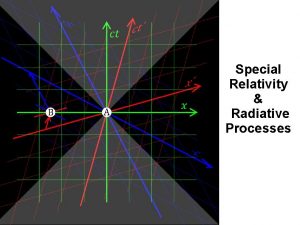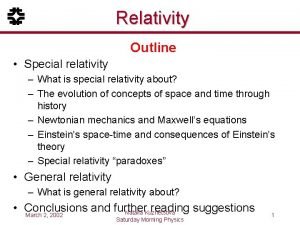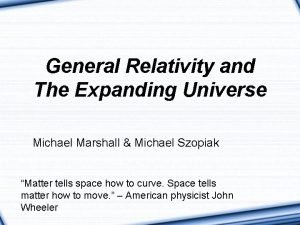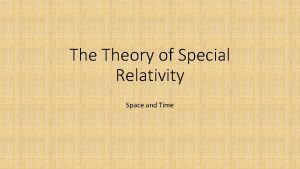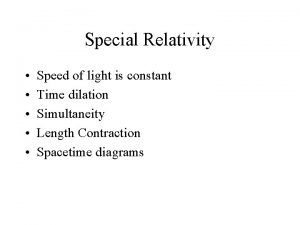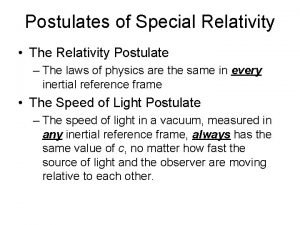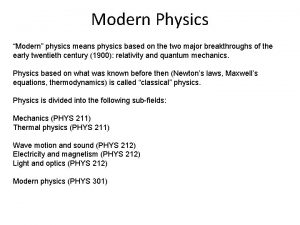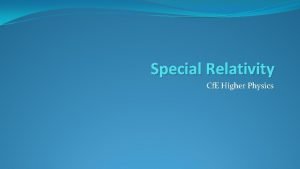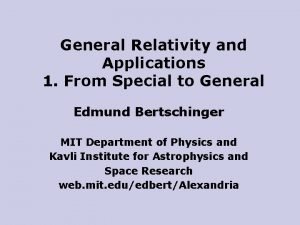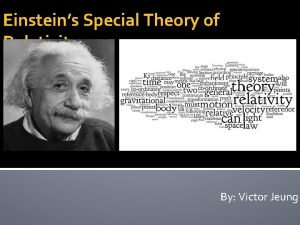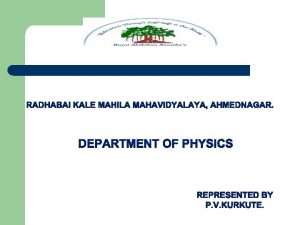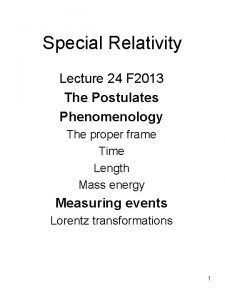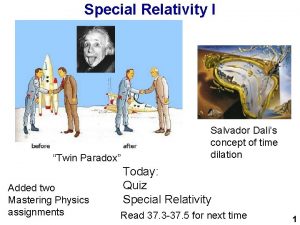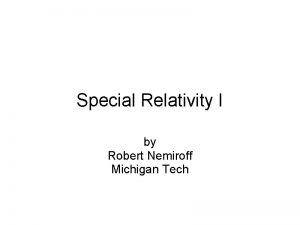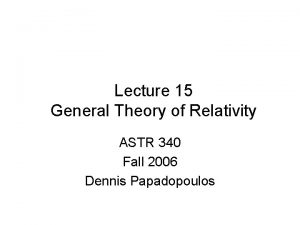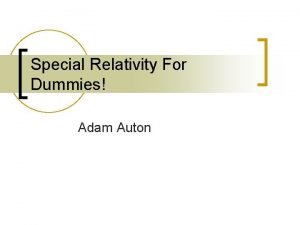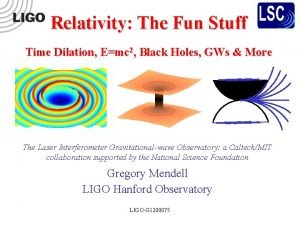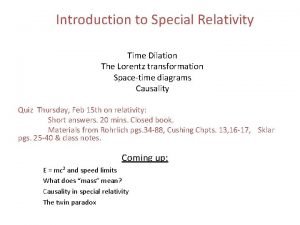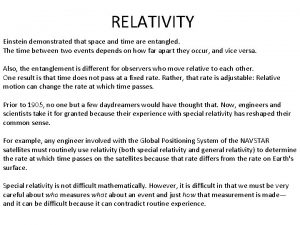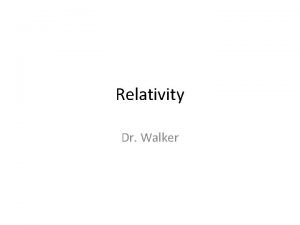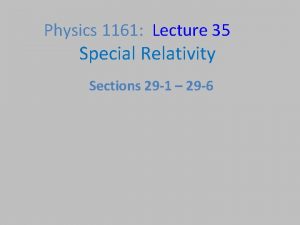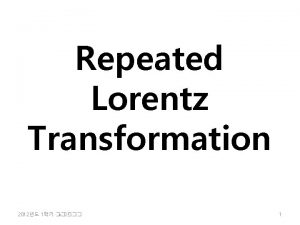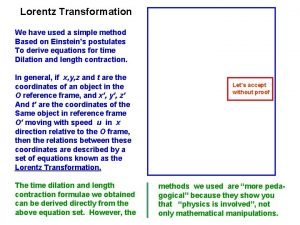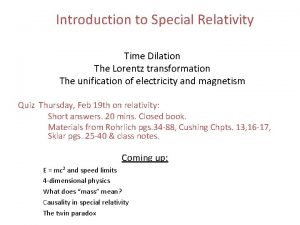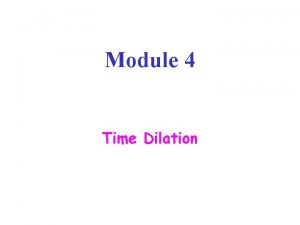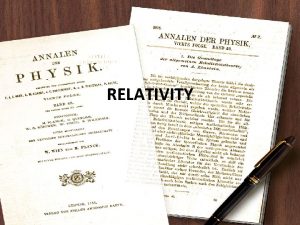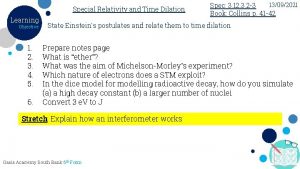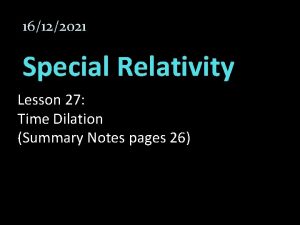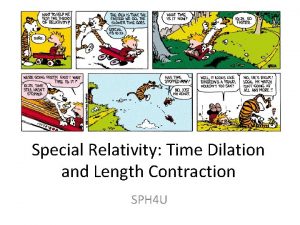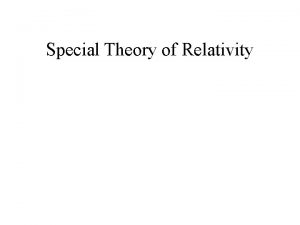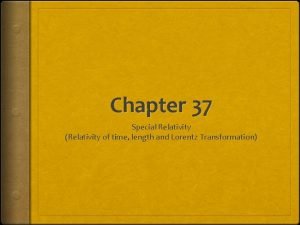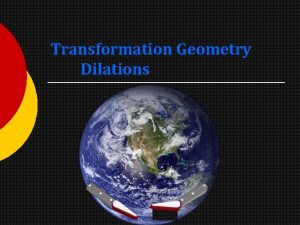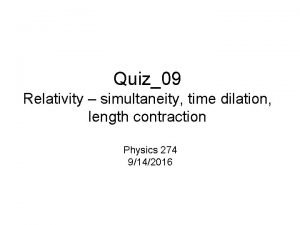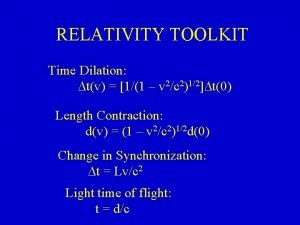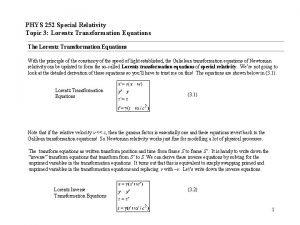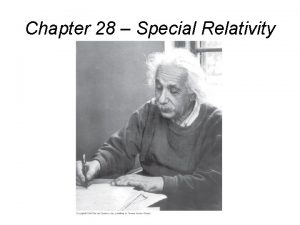Introduction to Special Relativity Time Dilation The Lorentz






























- Slides: 30

Introduction to Special Relativity Time Dilation The Lorentz transformation Space-time diagrams Causality Quiz Thursday, Feb 15 th on relativity: Short answers. 20 mins. Closed book. Materials from Rohrlich pgs. 34 -88, Cushing Chpts. 13, 16 -17, Sklar pgs. 25 -40 & class notes. Coming up: E = mc 2 and speed limits What does “mass” mean? Causality in special relativity The twin paradox

Einstein's approach • Initially motivated by Mach’s conception of a completely relationist universe. (For Mach, even acceleration was relative. ) Precursors to special relativity retained the notion of absolute space in the guise of the ether. For Poincaré the ether had become as undetectable as Newton’s absolute space. This was unsatisfying to Einstein. • Why does one use one equation to describe a conductor moving past a magnet and another to describe a magnet moving past a conductor? – “It is known that Maxwell’s electrodynamics – as usually understood at the present time – when applied to moving bodies, leads to asymmetries which do not appear to be inherent in the phenomena. ” Einstein, “On the Electrodynamics of Moving Bodies, Annalen der Physik, 17 (1905). • "The phenomena of electrodynamics as well as of mechanics possess no properties corresponding to the idea of absolute rest. The same laws. . . will be valid for all frames of reference. ” Einstein • That postulate (relativity) sounds familiar, but how can we combine it with Maxwell's equations?

Einstein’s two Postulates 1. “If, relative to K, K’ is a uniformly moving coordinate system devoid of rotation, then natural phenomena run their course with respect to K’ according to the same general laws as with respect to K. This statement is called the principle of relativity (in the restricted sense). ” Einstein, Relativity, p. 16. • This principle applies to all phenomena (including electrical and optical), not merely mechanical. So, what to do about Maxwell’s equations? We accept them: 2. “. . . experience in this domain leads conclusively to a theory of electromagnetic phenomena, of which the law of constancy of the velocity of light in vacuo is a necessary consequence. ” p. 23. • The insistence that these two "apparently incompatible" principles are consistent is the new idea. • Let's see more carefully why these two ideas seem inconsistent- the worst thing you can do is to simply accept them without drawing the necessary consequences.

Implications Let's say speed of light = c in ALL inertial reference frames. A and B are inertial observers moving at different speeds, C is a light pulse. Just for convenience, let them all start out at the same spot at t=0. A d. AB B d. AC d. BC C (d. AB here means the distance to B measured from A by A) What do we think we know? • Therefore our two postulates cannot both be true unless something is drastically wrong with our basic ideas about space and/or time! • If you think you can just accept both postulates as reasonable, you haven't got it. Possible changes:

Simultaneity (see Einstein, ch 9) • Suppose a train is moving past Fred, who is standing on the embankment. Barney is riding in the middle of the train. Two lightning strokes hit the ends of the train at times such that Barney sees the two flashes at the same time. At that instant, he is passing by Fred (i. e. , they are at the same place when they see the flashes). • • The question is, “Were the two lightning strokes simultaneous? ” Barney says: – The lightning hit the two ends of the train, which are the same distance from me. Since I saw the two flashes at the same time, the two strokes must have occurred at the same time, namely L/c before I saw the flashes. • Fred says: – When the lightning struck (some time in the past) the front of the train was closer to me than it is now, and the rear was farther. Thus the two flashes traveled different distances. Since I am seeing them at the same time, they must not have been simultaneous. The one at the rear happened first.

Who is right? • There is no way to tell who is right, so: Simultaneity of distant events depends on the motion of the observers. • Like time dilation, this results from the invariance of the speed of light. It depends on Fred and Barney both seeing light from flashes moving at c, even though they are moving w. r. t. each other. – It is impossible to prove that the light moves the same speed in both directions. That is an assumption, based on the apparent isotropy of space, and the simplicity of Maxwell's equations. – We could consider a different pair of strokes, which Fred says are simultaneous. They wouldn’t be at the ends of the moving train. Barney will say that they aren’t simultaneous.

What’s Relative? • Being at the same place (at different times) is also relative. This was known by Galileo. Think about the meal you eat while travelling on a boat. – Notice: we assumed that simultaneity at the same place was objective. If Fred was at the same place as Barney at the time one light flash reached, and Barney says they reached simultaneously, Fred was also there when the other flash hit. • Important note: once again relativity is NOT a trivial reminder that "it takes a while to see things because light has a finite speed. " Romer knew that, and it led to no changes in anyone's picture of space-time. If relativity seems obvious to you, you have not yet got it. • Relativity is a description of the symmetry of space-time. If the "c" that appeared in the equations didn't correspond to the speed of something we use to view events, or even to the speed of anything at all, the structure of theory would not change at all. It would just be harder to illustrate theory.

Do Perpendicular Lengths Change? • The Michelson-Morley result implied that the ratio of the length along the motion to the length at right angles to it shrank by a factor of SQRT(1 -v 2/c 2) • We now argue that lengths perpendicular to the motion remain unchanged. Moving observers agree about the dimensions of objects along directions transverse to the relative motion. – Can you figure out why? If the moving rod either shrinks or grows, that determines which rod leaves scratches on the inside of the other. But by symmetry, it has to go the other way as well. Anybody can come by at any later time and see who actually got scratched. So it's an objective feature, and everybody has to agree how it came out. By symmetry, the two lengths must then be the same in either frame. A B A OR Notice that the argument implicitly assumes that some features of the observed world must be invariant. B

Time Dilation • We immediately derive that two observers (moving w. r. t. each other) cannot agree about time intervals. • First, define “clock”: an object which repeats a process many times. A simple clock might be a pair of mirrors with a pulse of light bouncing back and forth. Three “snapshots”: Consider what happens when two identical clocks are moving w. r. t each other. Look at the path the light travels: K says that the moving clock ticks slowly by a factor of 1/ (1 -v 2/c 2)1/2 , because the light travels farther between bounces, while still moving at speed c.

Who has the right time? • The principle of relativity tells us that K’ (the person who owns the "moving" clock) will reverse the roles of the two clocks. K’ will say that the clock owned by K is moving and ticking slowly. • There is no non-arbitrary way to answer the question, “Who is right? ” (Here, there's not even agreement about who's running faster, much less about who's right. ) As a consequence: – There is no absolute time. • The size of the effect is the same as Lorentz’ time dilation, but it is conceptually different. For Lorentz there was a preferred frame (the ether), and all clocks moving through the ether ran slowly with respect to absolute time. Now there is no preferred frame. Each person says that clocks moving wrt him are running slowly. • Just to be sure you understand. . . – The reason K and K’ disagree about the clocks is that although they see the light taking different paths, they both say the light is travelling at c relative to themselves. It is NOT a matter of them being too stupid to correct for the travel time of the light- their corrections disagree because they disagree about the relative speed of the light wrt to different objects.

Are there any “real” effects in all this? • Consider cosmic ray muons, which are produced in the upper atmosphere, 25 -50 km above the ground. These particles only live about 2 microseconds, in which time they can only travel a few hundred meters at the speed of light. Nevertheless, a large number of them make it to the ground. How is this possible? • The solution is time dilation. When we say that muons live for 2 µs, we mean as measured when the muon is at rest. A moving muon suffers (from our point of view) time dilation. Its clock runs slowly, and it lives longer. Time dilation factors of 100 are not uncommon in cosmic rays, so many muons survive the trip to the surface. • In order for SR to be self consistent all clocks must be affected the same way. Thus, time dilation is not a property of any specific mechanism, but of time itself. • What does the muon see?

Muon’s View • • • From its point of view, there is no time dilation, but the atmosphere (which is moving) is Lorentz contracted. In the 2 µs muon lifetime, the earth, traveling close to c, has time to collide with the muon because it starts close by. Both observers agree the muon will reach the surface. They disagree about why this is so, i. e. they disagree about the values of some particular quantities used in the calculation leading to the agreed conclusion about whether the event occurs. This is just one example from a huge number of applications. You can't even build a good electron microscope if you ignore relativity or make a GPS system accurate (position errors would accumulate several kilometers per day).

The symmetry of special relativity • Special Relativity is a symmetry of the laws of physics. It says that if you look at some set of events from any one of a collection of different reference frames in constant relative motion, the laws needed to describe the events don't change. Galilean relativity said the same thing. – But Maxwell's laws didn't obey Galilean relativity. – G's relativity made assumptions about how some particular quantities (distance, time, mass…) changed between different frames (i. e. that they didn't change) , and those assumptions turned out to be wrong. • In Special Relativity – Moving clocks run slowly, but each person thinks his clock is at rest. – Moving rulers are Lorentz contracted along the direction of motion, but each person thinks his ruler is at rest. – Another invariant feature is whether or not two objects are at the same place at the same time. Can you think of an argument why you would expect that to be invariant?

Lorentz transformation Remember how Galileo related space and time measurements made by moving observers (motion is along the x direction): Galileo-Newton Lorentz-Einstein Time intervals are the same for all observers γ is the time dilation factor: Time is no longer an absolute (invariant) quantity. Notice that distances (y, z) perpendicular to the relative motion of the two coordinate frames are unchanged, as we showed was necessary. The equations look somewhat simpler and more symmetrical if we use ct instead of t and define β = v/c:

Symmetry Groups • Both types of transformation are invertible: if you transform to a primed frame using relative velocity v, then transform using relative velocity -v, you get back the original coordinates. That's obvious for Galilean transforms, and you can easily check it for Lorentz transforms. That's one of the properties that make the transforms part of what's called a group of symmetries. Since you use the same type of transform either way, you can't get a clue as to which frame is the "proper" one. • Important note again: even if there were no such thing as light, or anything else that traveled at speed c relative to other stuff, all of the essential points of relativity are contained in the new rules for converting between coordinate systems. Our arguments about "what would observer A see by using light" are not essential, just convenient paths toward these transformations. The key point is NOT about practical limitations on observations, but rather what sets of variables different observers have to use to get nature to obey the same simple laws.

4 -dimensional spacetime • Three-dimensional geometry becomes a chapter in four-dimensional physics. . Space and time are to fade away into the shadows. (Minkowski, 1908) • The geometrical interpretation of SR is based on the similarity between rotations and Lorentz transformations. Take two coordinate systems, rotated with respect to each other: Coordinate rotation doesn’t change the distance between points P and Q: x’ 2 + y’ 2 = x 2 + y 2. sin 2 q + cos 2 q = 1 expresses this invariance of distance under rotations. The two people get different x and y, but agree about d. The Lorentz transformation looks ~like a rotation: (I’m ignoring y and z. ) You can verify that (t’)2 - x’ 2 = (t)2 - x 2. Although two observers measure different lengths and time intervals, they agree on the value of this quantity, the “interval”. (Note the minus sign, it's defined to be more like a time interval than a space interval. )

Relativity is full of invariants they just aren't the ones you expected. • Minkowski interpreted the invariant interval as a geometrical quantity in a non. Euclidean geometry. It has quantities similar to the trigonometric functions, called hyperbolic trigonometric functions (e. g. , hyperbolic sine, etc. ). • Using this mathematics, we can interpret the Lorentz transformation as a non. Euclidean “rotation”: Except for the - sign, this is like a rotation. That - sign is the indicator the time dimension is not like the 3 space dimensions. The universal speed, c, now has a geometrical meaning: the conversion factor between space and time units. Suppose we measured x in meters and y in feet: With these units, the quantity x 2 + y 2 is not invariant under rotations. In fact, until we make the units agree, we can’t even combine them. We must multiply y by a conversion factor, k, which is the number of meters per foot. Then x 2 + (ky)2 is invariant.

4 -dimensional physics • The principle of relativity requires that if the laws of physics are to be the same in every inertial reference frame, the quantities on both sides of an = sign must undergo the same Lorentz transformation so they stay equal. You cannot make any invariant from space or time variables alone. That's why we call the SR world 4 -D, and call the old world 3 -D + time. No true feature of the world itself is representable in the 3 spatial dimensions or the 1 time dimension separately. • In Newtonian physics, p=mv (bold means vector). Momentum and velocity are vectors, and mass is a scalar (invariant) under 3 -d rotations. This equation is valid even when we rotate our coordinates, because both sides of the equation are vectors. • The new “momentum” is a 4 -d vector (4 -vector for short). It’s fourth component is E/c, the energy. – The factor of c is needed to give it the same units as momentum. • The lengths of 3 -vectors remain unchanged under rotations. So does the invariant “length” of 4 -vectors under Lorentz transformations. The length 2 of a 4 -vector is the square of its "time" component minus the square of its space component: (E/c)2 - p 2 = (m 0 c 2)2

4 -D geometry • In the geometrical interpretation of SR, c is just a conversion factor, the number of meters per second. The geometrical interpretation of SR helped lead Einstein to general relativity, although it didn’t directly change the physics. • World lines A graph of an object’s position versus time: If an object is at rest in any inertial reference frame, its speed is less than c in every reference frame. The speed limit divides the spacetime diagram into causally distinct regions. Lorentz_transform_of_world_line. gif A, B, C, & D are events. A might be a cause of B, since effects produced by A can propagate to B. They cannot get to D without travelling faster than light, nor to C because it occurs before A. C might be a cause of A, B, and/or D. D could be a cause of B, since light can get from D to B. If the interval, (ct)2 - x 2, between pairs of events is positive (“timelike”), then a causal connection is possible. If it is negative (“spacelike”), then not.

Space-time diagrams Future (here) time space (present) Past (here)

Space-time diagrams Future (here) time Spacelike Light cone Can reach timelike inaccessible space (present) Can detect Past (here)

Spacetime from rocket Future (here) time Light cone Spacelike Can reach timelike space (present) inaccessible Can detect Past (here)

Space-time diagrams Future (here) Particle world line time Light cone Spacelike Can reach timelike inaccessible space (present) Can detect Past (here)

The locality of conservation laws • We have seen various conserved quantities such as energy, momentum and electric charge. Their conservation laws remain valid (in new form) in special relativity. SR makes these laws even more strict than they were before. • Consider a hypothetical process with conserved quantity, Q: • it possible in a short time interval (dx/dt > c) for some Q to be transferred a long distance from box 1 to box 2? – We want to conserve Q: Q 1+Q 2 = Q’ 1+Q’ 2. • Newton’s physics does not forbid such a process, but SR does. This follows from the relativity of simultaneity. Suppose that I see the transfer happen at a particular time. An observer moving w. r. t. me will say that the Q changes at the two boxes at two different times. So he says there is a time interval during which Q was not conserved. This violates the principle of relativity – both observers must obtain the same laws. • Thus, conservation laws only work if they are local. Q cannot hop around. It must move continuously from one place to another, no faster than c.

Causality in Special relativity • Strong form: No event can be affected in any way by events outside its past light cone. • Weak form: No information may be transmitted except forward within a light cone. • Weaker form: No information can be transmitted except within a light cone. • You may wonder why we make such pointless distinctions. Can't any "effect" be used to transmit information? Stay tuned. • In a deterministic world, the Strong form would mean that an event would be completely predictable on the basis of knowledge of its past cone alone. Observations OUTSIDE the past light cone might provide the same info in more convenient form, but would never be needed, because everything knowable about the event would be determined by the preceding events in the light cone. • What about in a world where things are not completely predictable on the basis of anything? The Strong form would mean that one could find within the past light cone enough information to obtain as much predictive accuracy as possible about an event.

What does “Nothing can travel faster than the speed of light” mean? We know that – no ordinary mass can go faster, because that would require infinite energy. – no conserved quantity can go faster, because then it would not be conserved in some reference frames. – If we believe that causation must go forward in time, then we know that no "information" can go faster than c, because that would allow backwards-in-time causation. • What happens if you can send info backward? Say you send your grandma info that somebody much cuter than your grandpa was about to move into her neighborhood. Then you aren't born. Then the info doesn't get sent. So you are born, so …….

What does "no object travels faster than c“ mean? If "no object travels faster than c", then the following aren't objects: – The bright spot made by a beacon shining on a wall. – The cutting point of a scissors. – The crest of an E-M wave in matter. (Certain materials have index of refraction less than 1 over some frequency range, hence a "phase velocity" greater than c for some light. ) The repetitive pattern carries no info! Only the breaks in the repeating pattern must travel slower than c. What are we then claiming? If we are to describe the world as having some primary constituents, with various higher-level phenomena just being patterns in the constituents' behavior, we want to restrict the primary constituents to those which don't travel faster than light. We claim there exists some complete description of the world in terms of constituents which don't travel faster than c.

Causality in Special relativity • Things: One version of positivism tried to reduce all statements to simple relations among "things". – "No two things can be in the same place at the same time. ” – "No thing can travel faster than the speed of light. " • So what is a “thing”? – Is the Mississippi river a thing? (What would Heraclitus (500 BC) have said? ) “rivers endure because the waters change” – Is a person a thing? – Is a moving bright spot on the wall a thing? • If you believe in external reality, is it necessary to believe it consists of well-defined things? – If not, what becomes of statements like those above? – Do things exist outside our description of events?

There is a speed limit • Galileo says velocities add like vectors: if – I measure you to have velocity v 1, and – You measure an object to have velocity v'2, then – I will measure the object to have velocity v 2 = v 1 + v'2. • This can’t be correct in special relativity, because everyone gets the same speed, c, for light. There is a general law of combination of velocities. (derivable from the L. T. ) Let's abbreviate: β= v/c. ) As above: – β = 1 means v = c. You can verify that if β 1 = 1 or β 2' = 1, then β 2 will be 1 as well. So if something is moving at the speed of light according to one person, it will be moving at that same speed according to all observers. • Example: – You measure a proton speed 0. 75 c. I say you are moving 0. 75 c in the same direction. I will not measure 1. 5 c for the proton’s speed, but rather 0. 96 c. – For small velocities (β 1 « 1 and β 2 « 1) this reduces to Galileo’s expression, because β 1β 2' is extremely small and can be ignored. This is an example of the correspondence principle; a new theory must agree with the old one in the old one’s region of validity.

Relativity is a Law • Relativity might have sounded like some vague "everything goes" claim initially- at least in the popular press. Now we are deriving specific new physical laws from it. • Relativity is a constraint on the physical laws. It says "No future physical law will be found which takes on different forms in different inertial frames. " • And “future laws” in 1905 include all the laws concerning nuclear forces, the form of quantum theory, … So far, the constraint holds!
 Special relativity vs general relativity
Special relativity vs general relativity Special vs general relativity
Special vs general relativity Special vs general relativity
Special vs general relativity Theory of relativity
Theory of relativity Special relativity
Special relativity Einstein’s postulates of special relativity
Einstein’s postulates of special relativity 2 postulates of special relativity
2 postulates of special relativity Document
Document Momentum special relativity
Momentum special relativity Mythbusters relative velocity
Mythbusters relative velocity Special relativity summary
Special relativity summary Albert einstein theory of special relativity
Albert einstein theory of special relativity Postulates of special theory of relativity
Postulates of special theory of relativity Postulates of special theory of relativity
Postulates of special theory of relativity Albert einstein twin paradox
Albert einstein twin paradox Special relativity
Special relativity Postulates of special theory of relativity
Postulates of special theory of relativity Relativity for dummies
Relativity for dummies Interstellar time dilation
Interstellar time dilation Time dilation equation
Time dilation equation Dilated time formula
Dilated time formula Law of relitivity
Law of relitivity Time dilation
Time dilation Time dilation
Time dilation Spacetime walker
Spacetime walker Time dilation
Time dilation For minutes. start.
For minutes. start. Lorentz transformation matrix
Lorentz transformation matrix Psk lorentz
Psk lorentz Lorentz transformations
Lorentz transformations Pengertian gaya magnet
Pengertian gaya magnet
